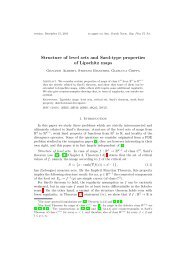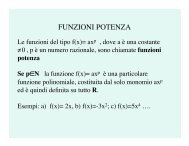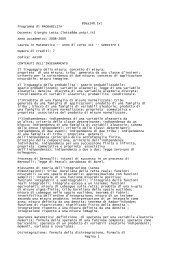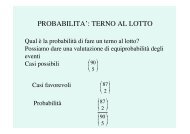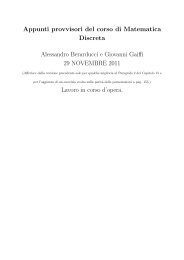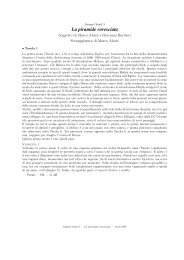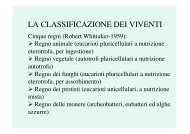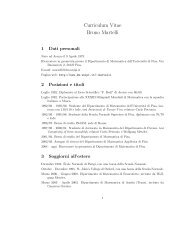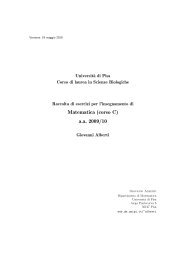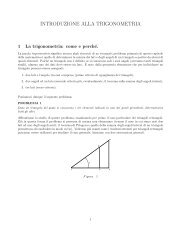Immersioni aperte in dimensione infinita - Dipartimento di Matematica
Immersioni aperte in dimensione infinita - Dipartimento di Matematica
Immersioni aperte in dimensione infinita - Dipartimento di Matematica
You also want an ePaper? Increase the reach of your titles
YUMPU automatically turns print PDFs into web optimized ePapers that Google loves.
10 Fenomeni della <strong><strong>di</strong>mensione</strong> <strong>in</strong>f<strong>in</strong>ita<br />
1.5.1 Il contributo <strong>di</strong> Bessaga<br />
Sia H, 〈·, ··〉 un arbitrario spazio <strong>di</strong> Hilbert <strong>di</strong> <strong><strong>di</strong>mensione</strong> <strong>in</strong>f<strong>in</strong>ita; denotiamo con | · | la norma<br />
<strong>in</strong>dotta da 〈·, ··〉. Sia S la sfera unitaria <strong>di</strong> H; Klee, [Kl 53], ha <strong>di</strong>mostrato che S è omeomorfa ad<br />
H (tale risultato è falso <strong>in</strong> <strong><strong>di</strong>mensione</strong> f<strong>in</strong>ita). Proveremo <strong>in</strong> questa sezione il seguente risultato più<br />
forte:<br />
Teorema 1.22 (Bessaga). Dotiamo S della sua struttura <strong>di</strong> sottovarietà <strong>di</strong> classe C ∞ <strong>in</strong>dotta da<br />
H. Allora esiste un <strong>di</strong>ffeomorfismo <strong>di</strong> classe C ∞ f da S su H:<br />
f : S ↠ H.<br />
Per provare questo teorema sono necessari i seguenti risultati <strong>in</strong>terme<strong>di</strong>:<br />
Lemma 1.23. Sia ω(·) una norma <strong>in</strong> H, <strong>di</strong> classe C ∞ su H \{O}, con ω(x) |x|. Allora esiste un<br />
<strong>di</strong>ffeomorfismo <strong>di</strong> classe C ∞ h2 <strong>di</strong> H su H che applica la palla unitaria chiusa {x ∈ H : |x| 1}<br />
sull’<strong>in</strong>sieme {x ∈ H : ω(x) 1}.<br />
Dimostrazione. Sia λ(t) una funzione reale non decrescente <strong>di</strong> classe C ∞ def<strong>in</strong>ita per t > 0, tale<br />
che λ(t) = 0 per t ≤ 1/2 e λ(t) = 1 per t ≥ 1. Sia<br />
h 2(x) =<br />
<br />
λ |x| |x|<br />
ω(x) + 1 − λ |x| <br />
x<br />
se x = 0 e h 2(0) = 0. Si verifica che (1) h 2 è una applicazione <strong>in</strong>iettiva da H su H; (2) h 2 trasforma<br />
la palla unitaria chiusa {x ∈ H : |x| 1} sull’<strong>in</strong>sieme {x ∈ H : ω(x) 1}; (3) h 2 è <strong>di</strong> classe C ∞ ;<br />
(4) usando un argomento <strong>di</strong> funzione implicita ([Di 69] teoremi 10.2.1 e 10.2.2) si conclude che h −1<br />
2<br />
è <strong>di</strong> classe C ∞ .<br />
Proposizione 1.24. Esiste un <strong>di</strong>ffeomorfismo <strong>di</strong> classe C ∞ h da H su H \ {O},<br />
tale che h(x) = x su x ∈ H : |x| 1/2 .<br />
h: H ↠ H \ {O},<br />
Dimostrazione. Si faccia riferimento al capitolo VI.2 del testo [Be 75] <strong>di</strong> Bessaga-Pe̷lczyński.<br />
Proposizione 1.25. Sia x0 <strong>in</strong> S. Allora esiste un <strong>di</strong>ffeomorfismo <strong>di</strong> classe C ∞ g da S su S \{x0}:<br />
Dimostrazione. Sia<br />
g(x) :=<br />
g : S ↠ S \ {x0}.<br />
<br />
x se 〈x, x0〉 < √ 3<br />
2 ,<br />
ϕ−1 x0 ◦ h ◦ ϕx0 (x) se 〈x, x0〉 √ 3<br />
2<br />
<strong>in</strong> cui h è def<strong>in</strong>ito nella proposizione 1.24. Ovviamente g è <strong>in</strong>iettivo e g(S) = S \ {x0}. Si verifica<br />
facilmente che, nelle notazioni <strong>in</strong>trodotte nell’osservazione 1.21,<br />
• se A ∋ y = x0, allora ϕy ◦ g ◦ ϕ −1<br />
y è l’identità su S;<br />
• ϕ −1<br />
x0<br />
◦ g ◦ ϕx0 e ϕ−1<br />
x0 ◦ g−1 ◦ ϕx0 sono <strong>di</strong> classe C∞ .<br />
Dunque g è un <strong>di</strong>ffeomorfismo <strong>di</strong> classe C ∞ .<br />
Siamo pronti per la <strong>di</strong>mostrazione del teorema <strong>di</strong> Bessaga:<br />
IMMERSIONI APERTE IN DIMENSIONE INFINITA



